Joint Moments and Powers in Healthy Young Adults
VerifiedAdded on 2022/08/22
|9
|2602
|24
AI Summary
Contribute Materials
Your contribution can guide someone’s learning journey. Share your
documents today.

1
Activity Analysis
Name of the author
The Name of the Class (Course)
Professor (Tutor)
The Name of the School (University)
The City and State
The Date
Activity Analysis
Name of the author
The Name of the Class (Course)
Professor (Tutor)
The Name of the School (University)
The City and State
The Date
Secure Best Marks with AI Grader
Need help grading? Try our AI Grader for instant feedback on your assignments.
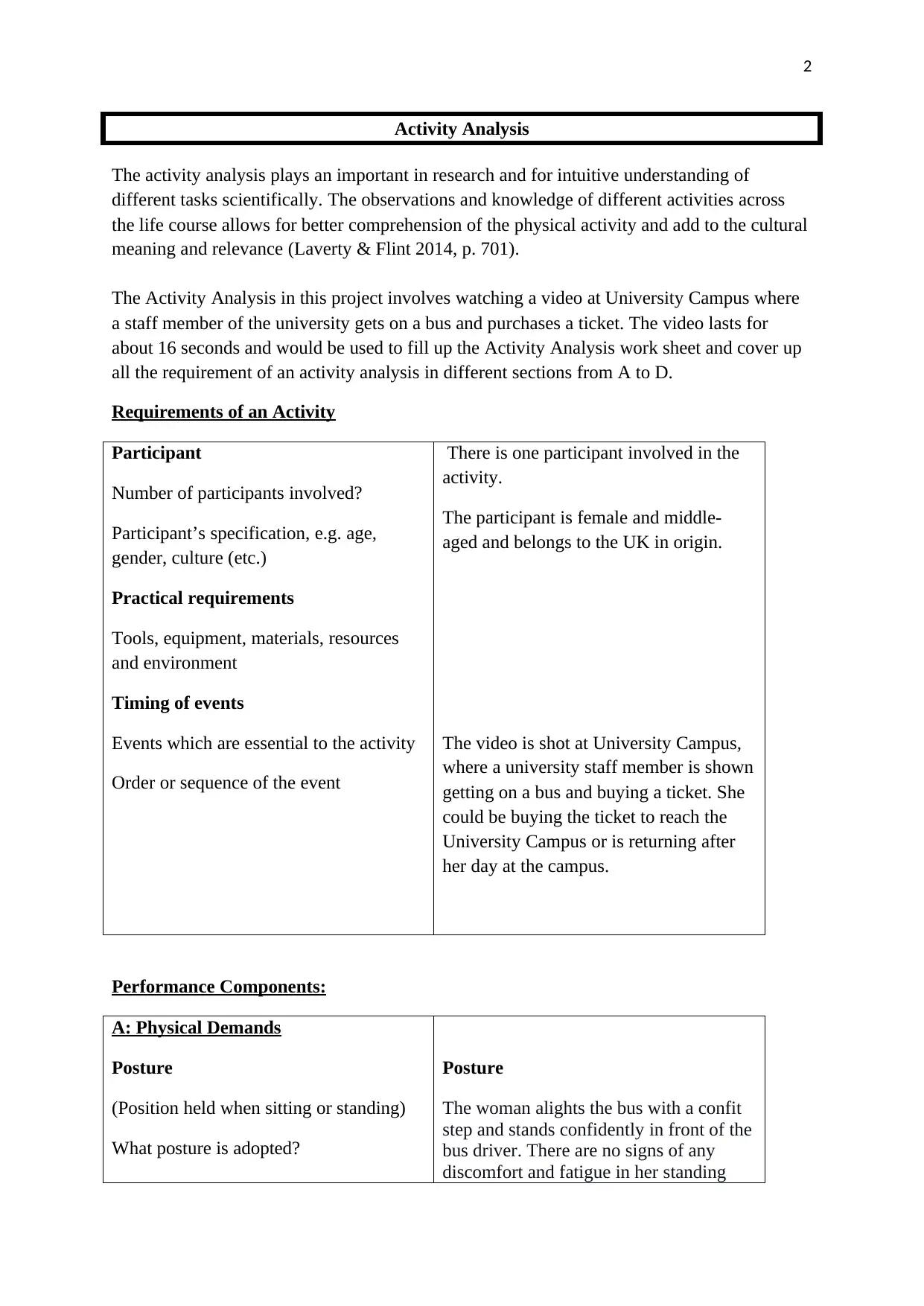
2
Activity Analysis
The activity analysis plays an important in research and for intuitive understanding of
different tasks scientifically. The observations and knowledge of different activities across
the life course allows for better comprehension of the physical activity and add to the cultural
meaning and relevance (Laverty & Flint 2014, p. 701).
The Activity Analysis in this project involves watching a video at University Campus where
a staff member of the university gets on a bus and purchases a ticket. The video lasts for
about 16 seconds and would be used to fill up the Activity Analysis work sheet and cover up
all the requirement of an activity analysis in different sections from A to D.
Requirements of an Activity
Participant
Number of participants involved?
Participant’s specification, e.g. age,
gender, culture (etc.)
Practical requirements
Tools, equipment, materials, resources
and environment
Timing of events
Events which are essential to the activity
Order or sequence of the event
There is one participant involved in the
activity.
The participant is female and middle-
aged and belongs to the UK in origin.
The video is shot at University Campus,
where a university staff member is shown
getting on a bus and buying a ticket. She
could be buying the ticket to reach the
University Campus or is returning after
her day at the campus.
Performance Components:
A: Physical Demands
Posture
(Position held when sitting or standing)
What posture is adopted?
Posture
The woman alights the bus with a confit
step and stands confidently in front of the
bus driver. There are no signs of any
discomfort and fatigue in her standing
Activity Analysis
The activity analysis plays an important in research and for intuitive understanding of
different tasks scientifically. The observations and knowledge of different activities across
the life course allows for better comprehension of the physical activity and add to the cultural
meaning and relevance (Laverty & Flint 2014, p. 701).
The Activity Analysis in this project involves watching a video at University Campus where
a staff member of the university gets on a bus and purchases a ticket. The video lasts for
about 16 seconds and would be used to fill up the Activity Analysis work sheet and cover up
all the requirement of an activity analysis in different sections from A to D.
Requirements of an Activity
Participant
Number of participants involved?
Participant’s specification, e.g. age,
gender, culture (etc.)
Practical requirements
Tools, equipment, materials, resources
and environment
Timing of events
Events which are essential to the activity
Order or sequence of the event
There is one participant involved in the
activity.
The participant is female and middle-
aged and belongs to the UK in origin.
The video is shot at University Campus,
where a university staff member is shown
getting on a bus and buying a ticket. She
could be buying the ticket to reach the
University Campus or is returning after
her day at the campus.
Performance Components:
A: Physical Demands
Posture
(Position held when sitting or standing)
What posture is adopted?
Posture
The woman alights the bus with a confit
step and stands confidently in front of the
bus driver. There are no signs of any
discomfort and fatigue in her standing
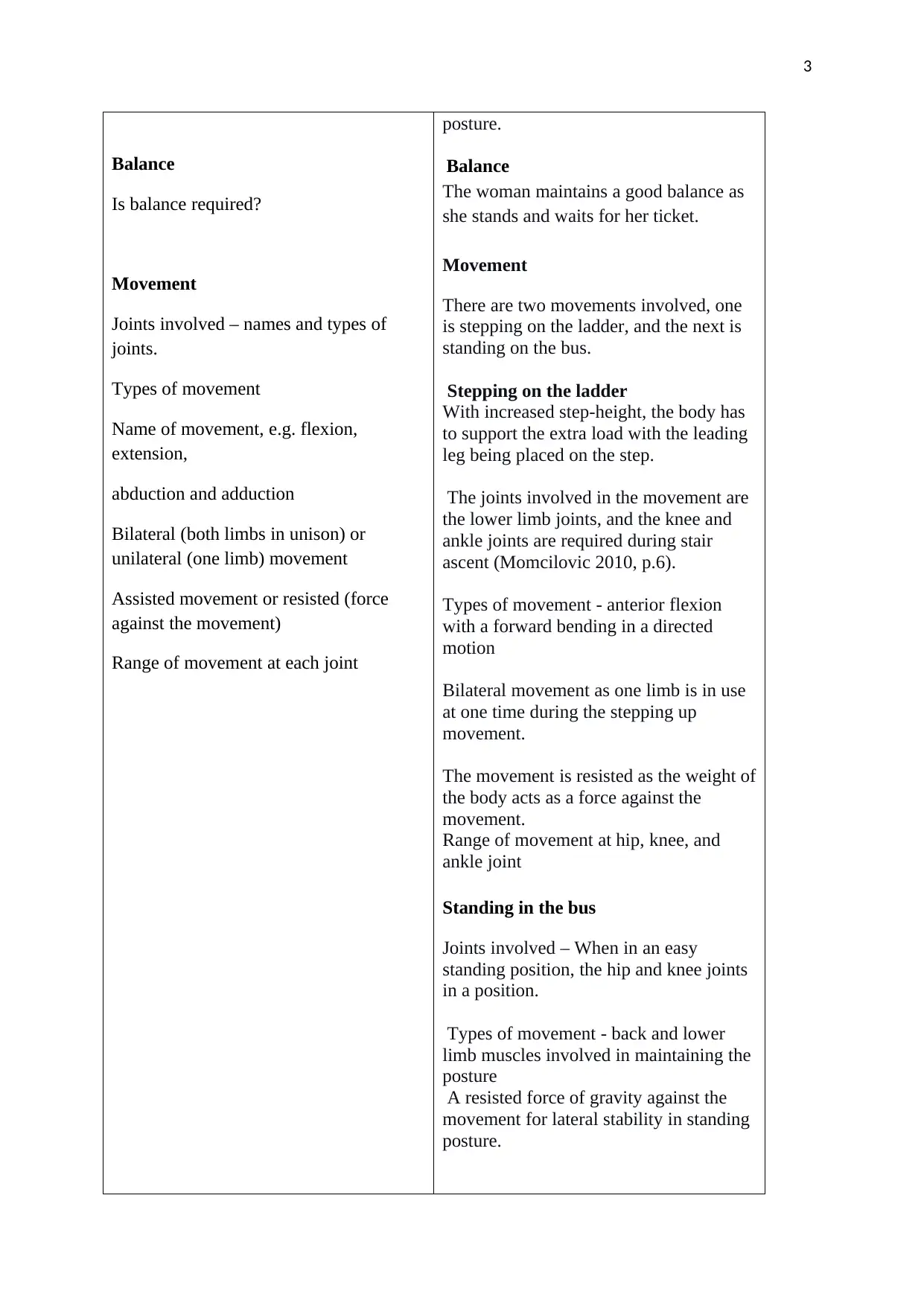
3
Balance
Is balance required?
Movement
Joints involved – names and types of
joints.
Types of movement
Name of movement, e.g. flexion,
extension,
abduction and adduction
Bilateral (both limbs in unison) or
unilateral (one limb) movement
Assisted movement or resisted (force
against the movement)
Range of movement at each joint
posture.
Balance
The woman maintains a good balance as
she stands and waits for her ticket.
Movement
There are two movements involved, one
is stepping on the ladder, and the next is
standing on the bus.
Stepping on the ladder
With increased step-height, the body has
to support the extra load with the leading
leg being placed on the step.
The joints involved in the movement are
the lower limb joints, and the knee and
ankle joints are required during stair
ascent (Momcilovic 2010, p.6).
Types of movement - anterior flexion
with a forward bending in a directed
motion
Bilateral movement as one limb is in use
at one time during the stepping up
movement.
The movement is resisted as the weight of
the body acts as a force against the
movement.
Range of movement at hip, knee, and
ankle joint
Standing in the bus
Joints involved – When in an easy
standing position, the hip and knee joints
in a position.
Types of movement - back and lower
limb muscles involved in maintaining the
posture
A resisted force of gravity against the
movement for lateral stability in standing
posture.
Balance
Is balance required?
Movement
Joints involved – names and types of
joints.
Types of movement
Name of movement, e.g. flexion,
extension,
abduction and adduction
Bilateral (both limbs in unison) or
unilateral (one limb) movement
Assisted movement or resisted (force
against the movement)
Range of movement at each joint
posture.
Balance
The woman maintains a good balance as
she stands and waits for her ticket.
Movement
There are two movements involved, one
is stepping on the ladder, and the next is
standing on the bus.
Stepping on the ladder
With increased step-height, the body has
to support the extra load with the leading
leg being placed on the step.
The joints involved in the movement are
the lower limb joints, and the knee and
ankle joints are required during stair
ascent (Momcilovic 2010, p.6).
Types of movement - anterior flexion
with a forward bending in a directed
motion
Bilateral movement as one limb is in use
at one time during the stepping up
movement.
The movement is resisted as the weight of
the body acts as a force against the
movement.
Range of movement at hip, knee, and
ankle joint
Standing in the bus
Joints involved – When in an easy
standing position, the hip and knee joints
in a position.
Types of movement - back and lower
limb muscles involved in maintaining the
posture
A resisted force of gravity against the
movement for lateral stability in standing
posture.
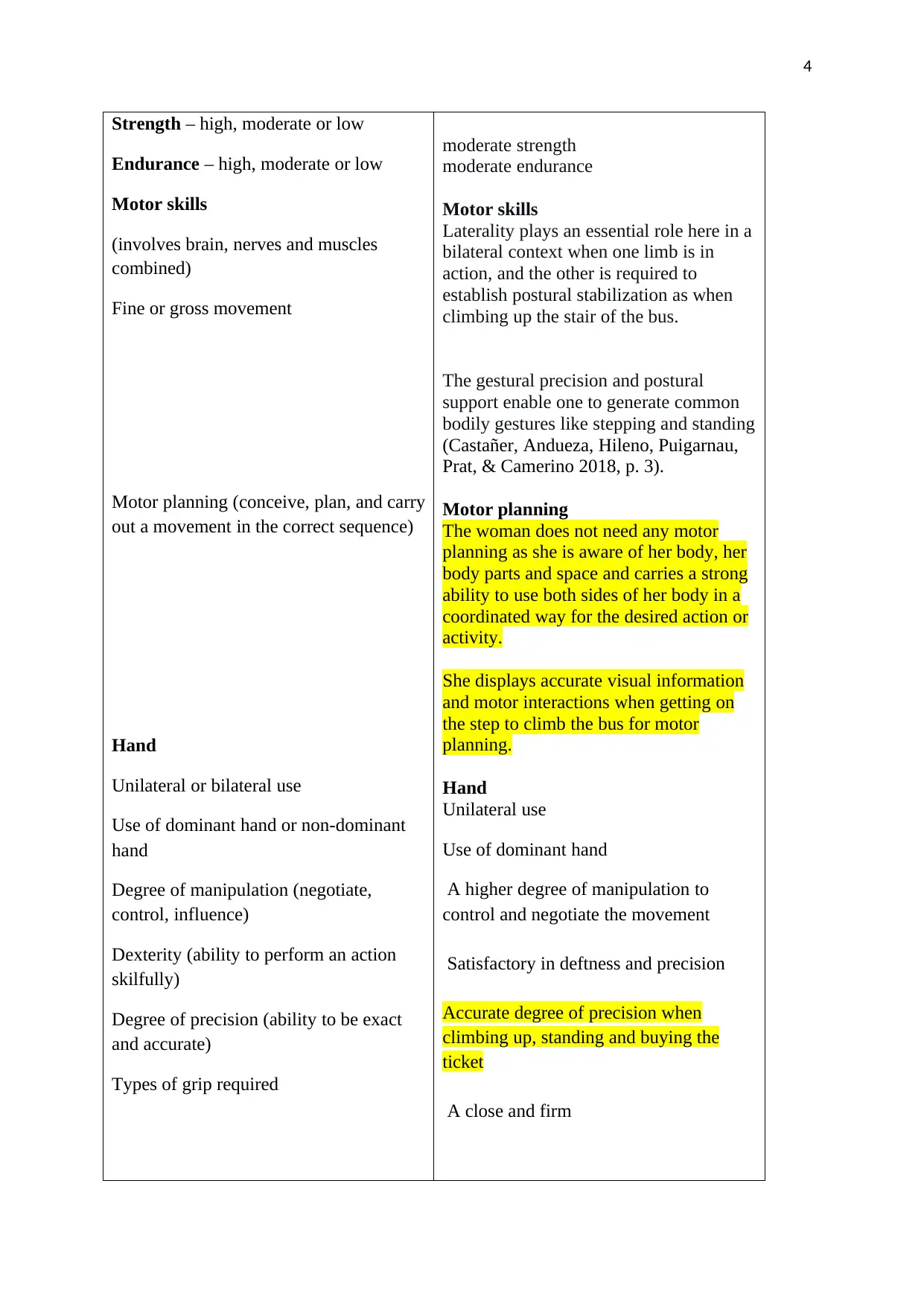
4
Strength – high, moderate or low
Endurance – high, moderate or low
Motor skills
(involves brain, nerves and muscles
combined)
Fine or gross movement
Motor planning (conceive, plan, and carry
out a movement in the correct sequence)
Hand
Unilateral or bilateral use
Use of dominant hand or non-dominant
hand
Degree of manipulation (negotiate,
control, influence)
Dexterity (ability to perform an action
skilfully)
Degree of precision (ability to be exact
and accurate)
Types of grip required
moderate strength
moderate endurance
Motor skills
Laterality plays an essential role here in a
bilateral context when one limb is in
action, and the other is required to
establish postural stabilization as when
climbing up the stair of the bus.
The gestural precision and postural
support enable one to generate common
bodily gestures like stepping and standing
(Castañer, Andueza, Hileno, Puigarnau,
Prat, & Camerino 2018, p. 3).
Motor planning
The woman does not need any motor
planning as she is aware of her body, her
body parts and space and carries a strong
ability to use both sides of her body in a
coordinated way for the desired action or
activity.
She displays accurate visual information
and motor interactions when getting on
the step to climb the bus for motor
planning.
Hand
Unilateral use
Use of dominant hand
A higher degree of manipulation to
control and negotiate the movement
Satisfactory in deftness and precision
Accurate degree of precision when
climbing up, standing and buying the
ticket
A close and firm
Strength – high, moderate or low
Endurance – high, moderate or low
Motor skills
(involves brain, nerves and muscles
combined)
Fine or gross movement
Motor planning (conceive, plan, and carry
out a movement in the correct sequence)
Hand
Unilateral or bilateral use
Use of dominant hand or non-dominant
hand
Degree of manipulation (negotiate,
control, influence)
Dexterity (ability to perform an action
skilfully)
Degree of precision (ability to be exact
and accurate)
Types of grip required
moderate strength
moderate endurance
Motor skills
Laterality plays an essential role here in a
bilateral context when one limb is in
action, and the other is required to
establish postural stabilization as when
climbing up the stair of the bus.
The gestural precision and postural
support enable one to generate common
bodily gestures like stepping and standing
(Castañer, Andueza, Hileno, Puigarnau,
Prat, & Camerino 2018, p. 3).
Motor planning
The woman does not need any motor
planning as she is aware of her body, her
body parts and space and carries a strong
ability to use both sides of her body in a
coordinated way for the desired action or
activity.
She displays accurate visual information
and motor interactions when getting on
the step to climb the bus for motor
planning.
Hand
Unilateral use
Use of dominant hand
A higher degree of manipulation to
control and negotiate the movement
Satisfactory in deftness and precision
Accurate degree of precision when
climbing up, standing and buying the
ticket
A close and firm
Secure Best Marks with AI Grader
Need help grading? Try our AI Grader for instant feedback on your assignments.
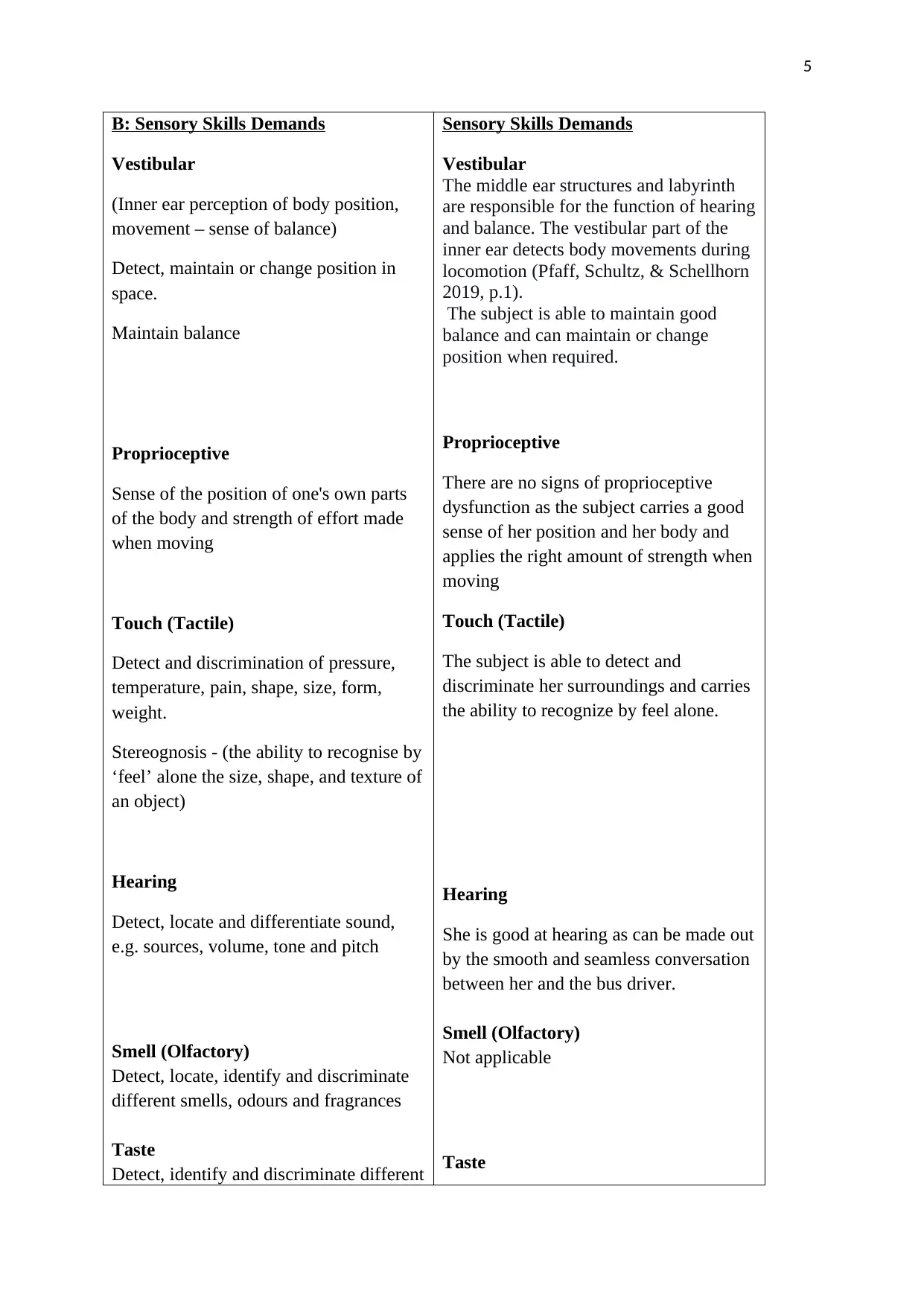
5
B: Sensory Skills Demands
Vestibular
(Inner ear perception of body position,
movement – sense of balance)
Detect, maintain or change position in
space.
Maintain balance
Proprioceptive
Sense of the position of one's own parts
of the body and strength of effort made
when moving
Touch (Tactile)
Detect and discrimination of pressure,
temperature, pain, shape, size, form,
weight.
Stereognosis - (the ability to recognise by
‘feel’ alone the size, shape, and texture of
an object)
Hearing
Detect, locate and differentiate sound,
e.g. sources, volume, tone and pitch
Smell (Olfactory)
Detect, locate, identify and discriminate
different smells, odours and fragrances
Taste
Detect, identify and discriminate different
Sensory Skills Demands
Vestibular
The middle ear structures and labyrinth
are responsible for the function of hearing
and balance. The vestibular part of the
inner ear detects body movements during
locomotion (Pfaff, Schultz, & Schellhorn
2019, p.1).
The subject is able to maintain good
balance and can maintain or change
position when required.
Proprioceptive
There are no signs of proprioceptive
dysfunction as the subject carries a good
sense of her position and her body and
applies the right amount of strength when
moving
Touch (Tactile)
The subject is able to detect and
discriminate her surroundings and carries
the ability to recognize by feel alone.
Hearing
She is good at hearing as can be made out
by the smooth and seamless conversation
between her and the bus driver.
Smell (Olfactory)
Not applicable
Taste
B: Sensory Skills Demands
Vestibular
(Inner ear perception of body position,
movement – sense of balance)
Detect, maintain or change position in
space.
Maintain balance
Proprioceptive
Sense of the position of one's own parts
of the body and strength of effort made
when moving
Touch (Tactile)
Detect and discrimination of pressure,
temperature, pain, shape, size, form,
weight.
Stereognosis - (the ability to recognise by
‘feel’ alone the size, shape, and texture of
an object)
Hearing
Detect, locate and differentiate sound,
e.g. sources, volume, tone and pitch
Smell (Olfactory)
Detect, locate, identify and discriminate
different smells, odours and fragrances
Taste
Detect, identify and discriminate different
Sensory Skills Demands
Vestibular
The middle ear structures and labyrinth
are responsible for the function of hearing
and balance. The vestibular part of the
inner ear detects body movements during
locomotion (Pfaff, Schultz, & Schellhorn
2019, p.1).
The subject is able to maintain good
balance and can maintain or change
position when required.
Proprioceptive
There are no signs of proprioceptive
dysfunction as the subject carries a good
sense of her position and her body and
applies the right amount of strength when
moving
Touch (Tactile)
The subject is able to detect and
discriminate her surroundings and carries
the ability to recognize by feel alone.
Hearing
She is good at hearing as can be made out
by the smooth and seamless conversation
between her and the bus driver.
Smell (Olfactory)
Not applicable
Taste
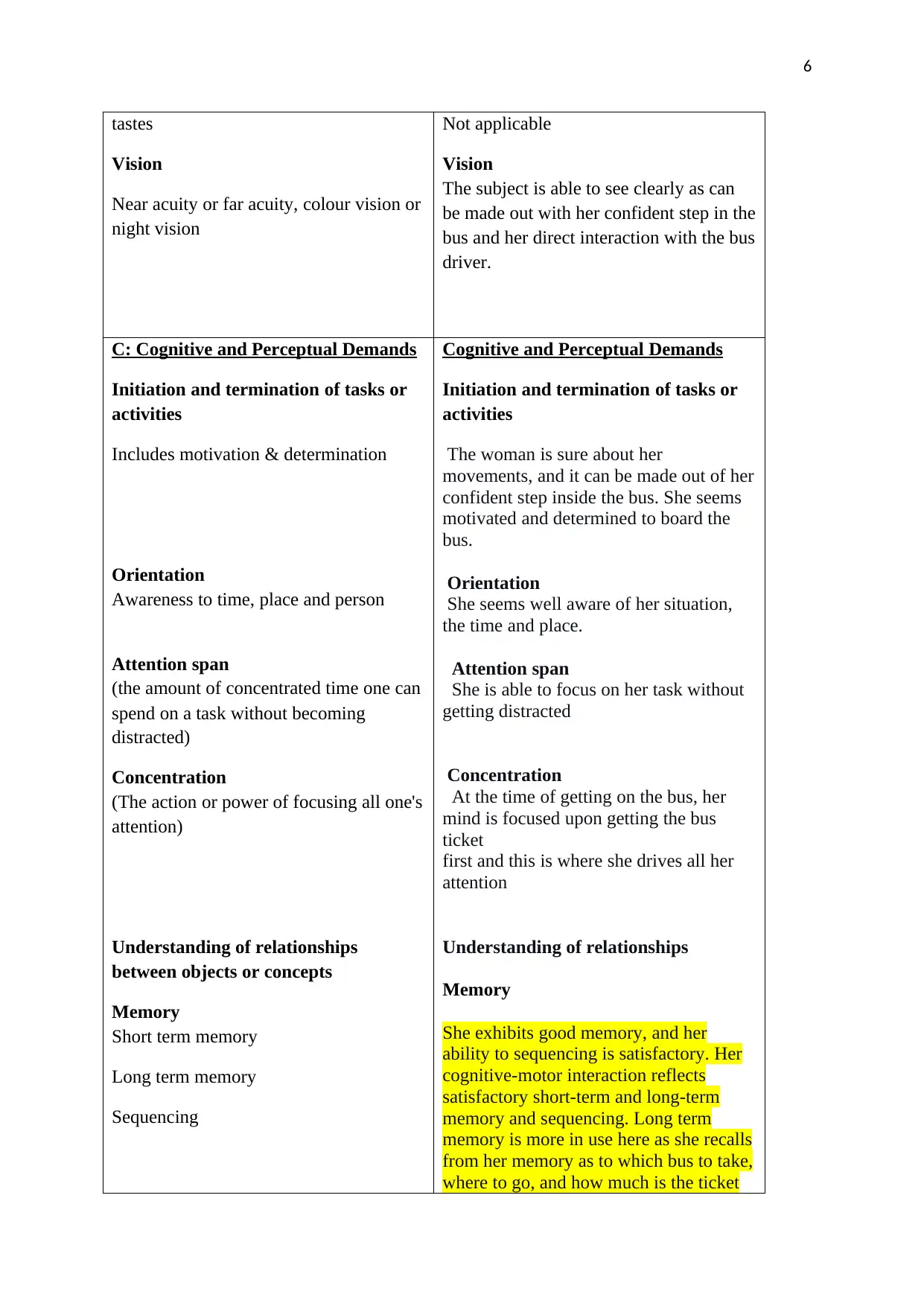
6
tastes
Vision
Near acuity or far acuity, colour vision or
night vision
Not applicable
Vision
The subject is able to see clearly as can
be made out with her confident step in the
bus and her direct interaction with the bus
driver.
C: Cognitive and Perceptual Demands
Initiation and termination of tasks or
activities
Includes motivation & determination
Orientation
Awareness to time, place and person
Attention span
(the amount of concentrated time one can
spend on a task without becoming
distracted)
Concentration
(The action or power of focusing all one's
attention)
Understanding of relationships
between objects or concepts
Memory
Short term memory
Long term memory
Sequencing
Cognitive and Perceptual Demands
Initiation and termination of tasks or
activities
The woman is sure about her
movements, and it can be made out of her
confident step inside the bus. She seems
motivated and determined to board the
bus.
Orientation
She seems well aware of her situation,
the time and place.
Attention span
She is able to focus on her task without
getting distracted
Concentration
At the time of getting on the bus, her
mind is focused upon getting the bus
ticket
first and this is where she drives all her
attention
Understanding of relationships
Memory
She exhibits good memory, and her
ability to sequencing is satisfactory. Her
cognitive-motor interaction reflects
satisfactory short-term and long-term
memory and sequencing. Long term
memory is more in use here as she recalls
from her memory as to which bus to take,
where to go, and how much is the ticket
tastes
Vision
Near acuity or far acuity, colour vision or
night vision
Not applicable
Vision
The subject is able to see clearly as can
be made out with her confident step in the
bus and her direct interaction with the bus
driver.
C: Cognitive and Perceptual Demands
Initiation and termination of tasks or
activities
Includes motivation & determination
Orientation
Awareness to time, place and person
Attention span
(the amount of concentrated time one can
spend on a task without becoming
distracted)
Concentration
(The action or power of focusing all one's
attention)
Understanding of relationships
between objects or concepts
Memory
Short term memory
Long term memory
Sequencing
Cognitive and Perceptual Demands
Initiation and termination of tasks or
activities
The woman is sure about her
movements, and it can be made out of her
confident step inside the bus. She seems
motivated and determined to board the
bus.
Orientation
She seems well aware of her situation,
the time and place.
Attention span
She is able to focus on her task without
getting distracted
Concentration
At the time of getting on the bus, her
mind is focused upon getting the bus
ticket
first and this is where she drives all her
attention
Understanding of relationships
Memory
She exhibits good memory, and her
ability to sequencing is satisfactory. Her
cognitive-motor interaction reflects
satisfactory short-term and long-term
memory and sequencing. Long term
memory is more in use here as she recalls
from her memory as to which bus to take,
where to go, and how much is the ticket
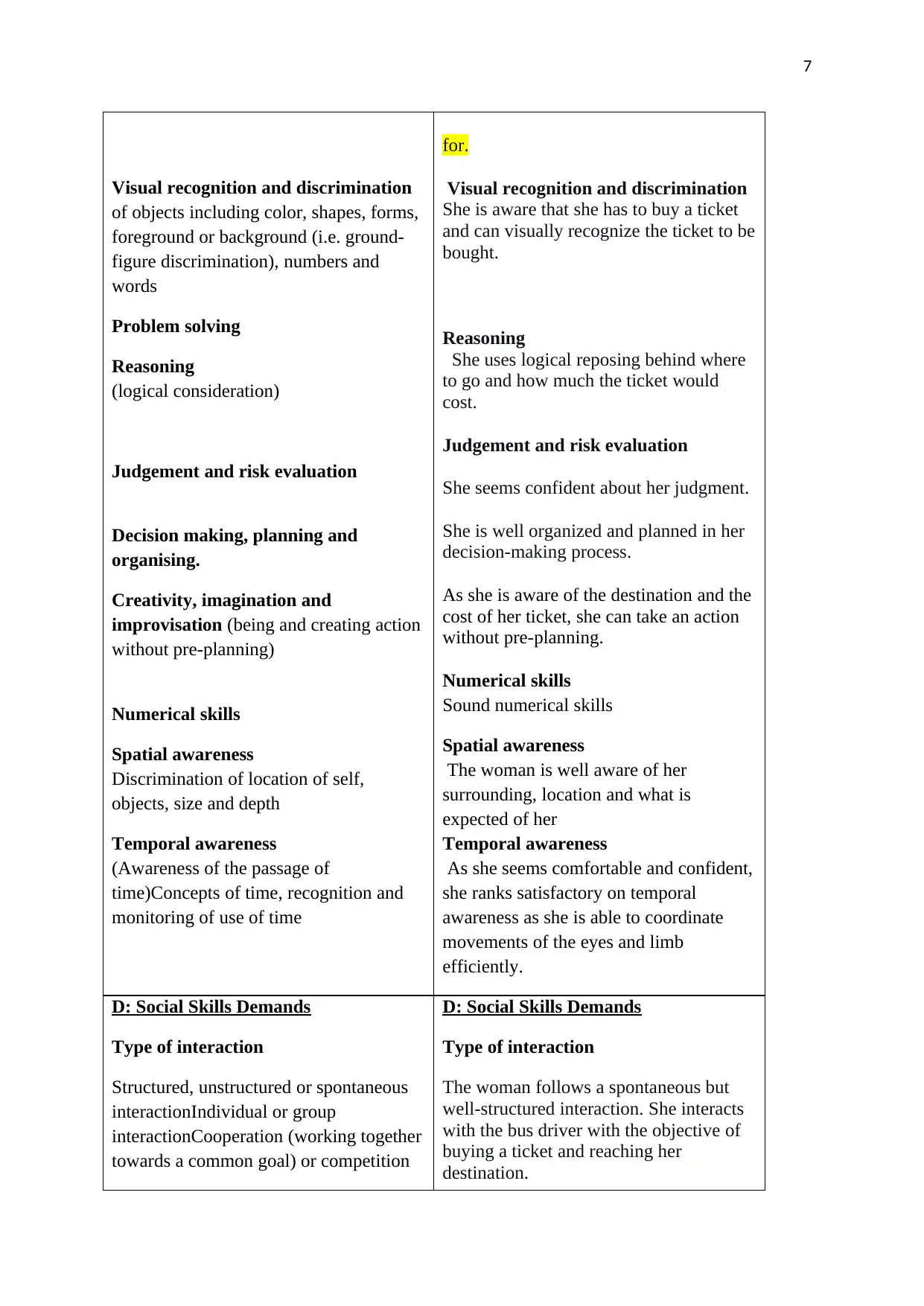
7
Visual recognition and discrimination
of objects including color, shapes, forms,
foreground or background (i.e. ground-
figure discrimination), numbers and
words
Problem solving
Reasoning
(logical consideration)
Judgement and risk evaluation
Decision making, planning and
organising.
Creativity, imagination and
improvisation (being and creating action
without pre-planning)
Numerical skills
Spatial awareness
Discrimination of location of self,
objects, size and depth
Temporal awareness
(Awareness of the passage of
time)Concepts of time, recognition and
monitoring of use of time
for.
Visual recognition and discrimination
She is aware that she has to buy a ticket
and can visually recognize the ticket to be
bought.
Reasoning
She uses logical reposing behind where
to go and how much the ticket would
cost.
Judgement and risk evaluation
She seems confident about her judgment.
She is well organized and planned in her
decision-making process.
As she is aware of the destination and the
cost of her ticket, she can take an action
without pre-planning.
Numerical skills
Sound numerical skills
Spatial awareness
The woman is well aware of her
surrounding, location and what is
expected of her
Temporal awareness
As she seems comfortable and confident,
she ranks satisfactory on temporal
awareness as she is able to coordinate
movements of the eyes and limb
efficiently.
D: Social Skills Demands
Type of interaction
Structured, unstructured or spontaneous
interactionIndividual or group
interactionCooperation (working together
towards a common goal) or competition
D: Social Skills Demands
Type of interaction
The woman follows a spontaneous but
well-structured interaction. She interacts
with the bus driver with the objective of
buying a ticket and reaching her
destination.
Visual recognition and discrimination
of objects including color, shapes, forms,
foreground or background (i.e. ground-
figure discrimination), numbers and
words
Problem solving
Reasoning
(logical consideration)
Judgement and risk evaluation
Decision making, planning and
organising.
Creativity, imagination and
improvisation (being and creating action
without pre-planning)
Numerical skills
Spatial awareness
Discrimination of location of self,
objects, size and depth
Temporal awareness
(Awareness of the passage of
time)Concepts of time, recognition and
monitoring of use of time
for.
Visual recognition and discrimination
She is aware that she has to buy a ticket
and can visually recognize the ticket to be
bought.
Reasoning
She uses logical reposing behind where
to go and how much the ticket would
cost.
Judgement and risk evaluation
She seems confident about her judgment.
She is well organized and planned in her
decision-making process.
As she is aware of the destination and the
cost of her ticket, she can take an action
without pre-planning.
Numerical skills
Sound numerical skills
Spatial awareness
The woman is well aware of her
surrounding, location and what is
expected of her
Temporal awareness
As she seems comfortable and confident,
she ranks satisfactory on temporal
awareness as she is able to coordinate
movements of the eyes and limb
efficiently.
D: Social Skills Demands
Type of interaction
Structured, unstructured or spontaneous
interactionIndividual or group
interactionCooperation (working together
towards a common goal) or competition
D: Social Skills Demands
Type of interaction
The woman follows a spontaneous but
well-structured interaction. She interacts
with the bus driver with the objective of
buying a ticket and reaching her
destination.
Paraphrase This Document
Need a fresh take? Get an instant paraphrase of this document with our AI Paraphraser
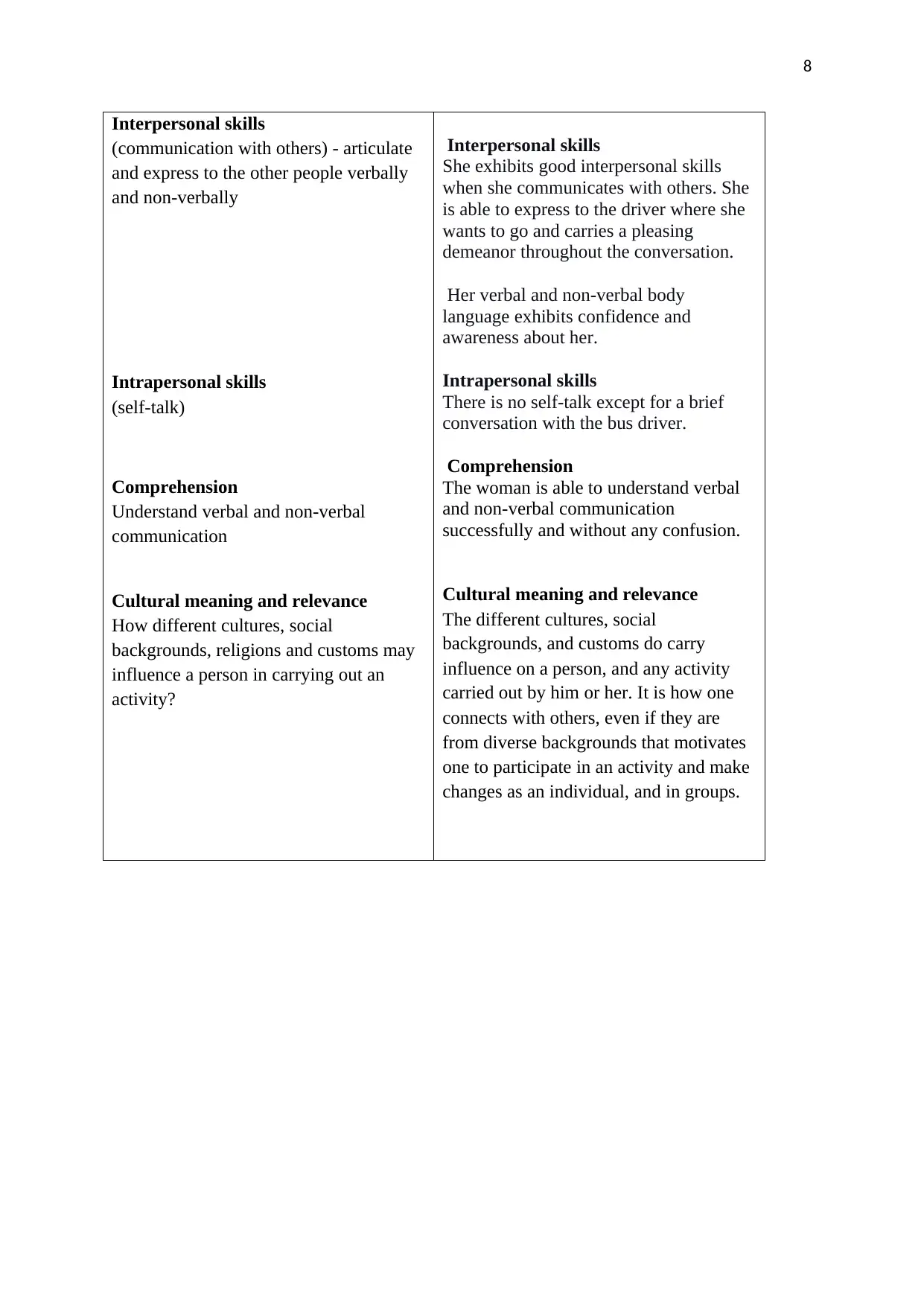
8
Interpersonal skills
(communication with others) - articulate
and express to the other people verbally
and non-verbally
Intrapersonal skills
(self-talk)
Comprehension
Understand verbal and non-verbal
communication
Cultural meaning and relevance
How different cultures, social
backgrounds, religions and customs may
influence a person in carrying out an
activity?
Interpersonal skills
She exhibits good interpersonal skills
when she communicates with others. She
is able to express to the driver where she
wants to go and carries a pleasing
demeanor throughout the conversation.
Her verbal and non-verbal body
language exhibits confidence and
awareness about her.
Intrapersonal skills
There is no self-talk except for a brief
conversation with the bus driver.
Comprehension
The woman is able to understand verbal
and non-verbal communication
successfully and without any confusion.
Cultural meaning and relevance
The different cultures, social
backgrounds, and customs do carry
influence on a person, and any activity
carried out by him or her. It is how one
connects with others, even if they are
from diverse backgrounds that motivates
one to participate in an activity and make
changes as an individual, and in groups.
Interpersonal skills
(communication with others) - articulate
and express to the other people verbally
and non-verbally
Intrapersonal skills
(self-talk)
Comprehension
Understand verbal and non-verbal
communication
Cultural meaning and relevance
How different cultures, social
backgrounds, religions and customs may
influence a person in carrying out an
activity?
Interpersonal skills
She exhibits good interpersonal skills
when she communicates with others. She
is able to express to the driver where she
wants to go and carries a pleasing
demeanor throughout the conversation.
Her verbal and non-verbal body
language exhibits confidence and
awareness about her.
Intrapersonal skills
There is no self-talk except for a brief
conversation with the bus driver.
Comprehension
The woman is able to understand verbal
and non-verbal communication
successfully and without any confusion.
Cultural meaning and relevance
The different cultures, social
backgrounds, and customs do carry
influence on a person, and any activity
carried out by him or her. It is how one
connects with others, even if they are
from diverse backgrounds that motivates
one to participate in an activity and make
changes as an individual, and in groups.
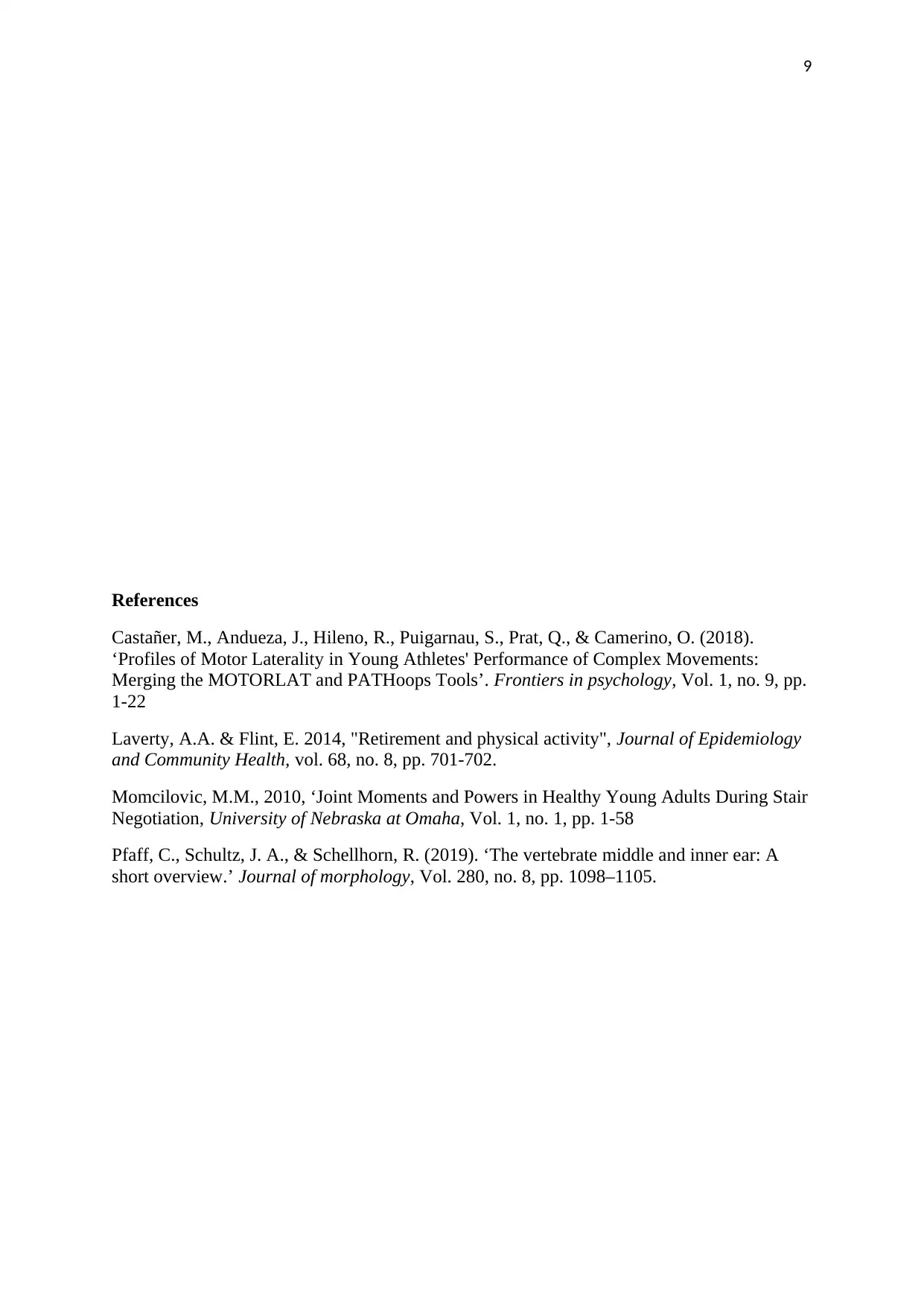
9
References
Castañer, M., Andueza, J., Hileno, R., Puigarnau, S., Prat, Q., & Camerino, O. (2018).
‘Profiles of Motor Laterality in Young Athletes' Performance of Complex Movements:
Merging the MOTORLAT and PATHoops Tools’. Frontiers in psychology, Vol. 1, no. 9, pp.
1-22
Laverty, A.A. & Flint, E. 2014, "Retirement and physical activity", Journal of Epidemiology
and Community Health, vol. 68, no. 8, pp. 701-702.
Momcilovic, M.M., 2010, ‘Joint Moments and Powers in Healthy Young Adults During Stair
Negotiation, University of Nebraska at Omaha, Vol. 1, no. 1, pp. 1-58
Pfaff, C., Schultz, J. A., & Schellhorn, R. (2019). ‘The vertebrate middle and inner ear: A
short overview.’ Journal of morphology, Vol. 280, no. 8, pp. 1098–1105.
References
Castañer, M., Andueza, J., Hileno, R., Puigarnau, S., Prat, Q., & Camerino, O. (2018).
‘Profiles of Motor Laterality in Young Athletes' Performance of Complex Movements:
Merging the MOTORLAT and PATHoops Tools’. Frontiers in psychology, Vol. 1, no. 9, pp.
1-22
Laverty, A.A. & Flint, E. 2014, "Retirement and physical activity", Journal of Epidemiology
and Community Health, vol. 68, no. 8, pp. 701-702.
Momcilovic, M.M., 2010, ‘Joint Moments and Powers in Healthy Young Adults During Stair
Negotiation, University of Nebraska at Omaha, Vol. 1, no. 1, pp. 1-58
Pfaff, C., Schultz, J. A., & Schellhorn, R. (2019). ‘The vertebrate middle and inner ear: A
short overview.’ Journal of morphology, Vol. 280, no. 8, pp. 1098–1105.
1 out of 9
Your All-in-One AI-Powered Toolkit for Academic Success.
+13062052269
info@desklib.com
Available 24*7 on WhatsApp / Email
![[object Object]](/_next/static/media/star-bottom.7253800d.svg)
Unlock your academic potential
© 2024 | Zucol Services PVT LTD | All rights reserved.

